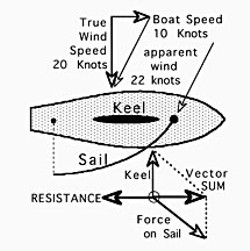[
{
"name": "Top Stories Video Pair",
"insertPoint": "7",
"component": "17087298",
"parentWrapperClass": "fdn-ads-inline-content-block",
"requiredCountToDisplay": "1"
}
]
The physics of sailing is outlined in the first diagram, showing the equilibrium between forces. The vector-sum of forces on sail and keel is balanced by the resistance of moving the boat through water.
The speed of a typical 10-meter yacht in winds of 10 and 20 knots, as a function of its angle to the wind, is shown in the second diagram (1 knot = 1.15 mph and 1 mile = 1.6 km). As shown in the third diagram, the length of the yacht is important because the speed of the induced bow wave varies with the wave's length. It is difficult for a boat to exceed the speed of a wave whose wavelength is longer than the boat, because the boat is then attempting to climb up the wave. With sufficient power, however, a speed-boat can ride up upon its bow wave and effectively hydroplane.
Although the maximum speed of a typical yacht is less than the wind speed, high-tech catamaran yachts have reached speeds about twice that of the wind. A windsurfer narrowly beat the yachting record this year with a speed of 49 knots (56 mph). The land yacht record is 117 m.p.h. in 30 m.p.h. winds!
Speaking of Science
-

HSU Expanding Curriculum with Polytechnic Push
Jun 15, 2021 -

Davos Won't Save Us
Jan 23, 2020 -

The Need to Study Weed
Jan 16, 2020 - More »
more from the author
-
Nuclear Matters
- May 6, 2010
-
Sophie Smells a Shaker
- Feb 4, 2010
-
The Roots of Love
- Feb 5, 2009
- More »
































